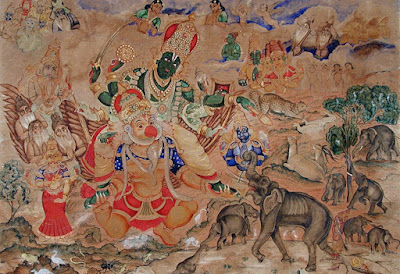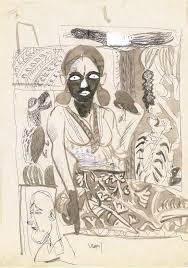more and more layers and then nature – just like after a long tour I’m back to home and taking a rest.
Year: 2020
..विष्णुधर्मोत्तर पुराण और कला
विष्णुधर्मोत्तर पुराण और कला
भारत में चित्रकला का एक प्राचीन स्रोत विष्णुधर्मोत्तर पुराण है। विष्णुधर्मोत्तर पुराण मार्कण्डेय द्वारा रचित है। इसमें लगभग १६ हजार श्लोक हैं जिनका संकलन ६५० ई. के आस-पास हुआ। इसके तीन खण्ड हैं। प्रथम खण्ड में २६९ अध्याय हैं, द्वितीय खण्ड में १८३ अध्याय तथा तृतीय खण्ड में ११८ अध्याय हैं।
विष्णुधर्मोत्तर पुराण के ‘चित्रसूत्र’ नामक अध्याय में चित्रकला का महत्त्व इन शब्दों में बताया गया है-
कलानां प्रवरं चित्रम् धर्मार्थ काम मोक्षादं।
मांगल्य प्रथम् दोतद् गृहे यत्र प्रतिष्ठितम् ॥
कलाओं में चित्रकला सबसे ऊँची है जिसमें धर्म, अर्थ, काम एवम् मोक्ष की प्राप्ति होती है। अतः जिस घर में चित्रों की प्रतिष्ठा अधिक रहती है, वहाँ सदा मंगल की उपस्थिति मानी गई है।
विष्णुधर्मोत्तर पुराण एक उपपुराण है। इसकी प्रकृति विश्वकोशीय है। कलाओं के अतिरिक्त इसमें ब्रह्माण्ड, भूगोल, खगोलशास्त्र, ज्योतिष, काल-विभाजन, कुपित ग्रहों एवं नक्षत्रों को शान्त करना, प्रथाएँ, तपस्या, वैष्णवों के कर्तव्य, कानून एवं राजनीति, युद्धनीति, मानव एवं पशुओं के रोगों की चिकित्सा, खानपान, व्याकरण, छन्द, शब्दकोश, भाषणकला, नाटक, नृत्य, संगीत और अनेकानेक कलाओं की चर्चा की गयी है। यह विष्णुपुराण का परिशिष्ट माना जाता है।
प्रथम खण्ड में २६९ अध्याय हैं जिनमें अन्य पुराणों के समान संसार की उत्पत्ति, भूगोल सम्बन्धी वर्णन, ज्योतिष, राजाओं और ऋषियों की वंशावलियां आदि और शंकरगीता, पुरूरवा, उर्वर्शी की कथा, श्राद्ध, वृत आदि स्रोत आदि विषय हैं।
द्वितीय खण्ड के १८३ अध्यायों में धर्म, राजनीति, आश्रम, ज्योतिष का पैतामह-सिद्धान्त, औषधि विज्ञान आदि मानव के नित्य प्रति के जीवन से संबन्धित विषय हैं।
तृतीय खण्ड में ११८ अध्याय हैं। इसमें संस्कृत और प्राकृत का व्याकरण, शब्दकोष, छन्दशास्त्र, काव्यशास्त्र, आदि साहित्यिक विषय तो हैं ही नृत्य और संगीत आदि ललित कलायें और वास्तु जैसी ललित शिल्प-कलाओं का भी विस्तृत विवेचन हुआ है।
उल्लेखनीय है कि उसमें कलाओं के विशेषत: मूर्तिकला और चित्रकला के प्राविधिक ज्ञान को पूर्णता प्राप्त हुई है। उसकी प्रस्तावना में पुराकालीन नारायण मुनि द्वारा वर्णित किसी ‘चित्रसूत्र’ का उल्लेख करते हुए यह बताया गया है कि यह ग्रन्थ उसी पुरातन ग्रन्थ का पुन: संस्करण है। फिर भी यह निश्चित है कि यह अधिक बड़ा नहीं है, किन्तु छोटे या संक्षेप रूप में उसमें जो कुछ प्रतिपादित है, उसकी समकालीन तथा भावी कला पीढि़यों के लिए एकमात्र यही आधार बना रहा । उसके नौ अध्यायों का क्रम इस प्रकार है:1. आयाम मान वर्णन, 2. प्रमाण वर्णन. 3. सामान्य मान वर्णन, 4. प्रतिमा लक्षण वर्णन. 5. क्षयवृद्धि. 6. रंगव्यतिकर, 7. वर्तना, 8. रूप-निर्माण और 9. श्रृङ्गारादि भाव कथन ।
डॉक्टर जायसवाल का अभिमत है कि 5वीं या इसके बाद तक अधिकतर पुराणों के पुन: संस्करण हो चुके थे। पार्जिटर और हजारा आदि विद्वानों ने ‘विष्णुधर्मोत्तर पुराण’ को छठी शती का बताया है। बूलर ने अनेक प्रमाणों से इसकी पुष्टि करते हुए यह स्थापित किया है कि उक्त पुराण की रचना काश्मीर में हुई। गुप्तयुगीन भारत के विद्या केन्द्रों में कश्मीर का भी एक नाम था। गुप्तयुगीन काश्मीर में उन दिनों कवि मातृगुप्त का शासन था, जिसकी नियुक्ति तत्कालीन गुप्त सम्राट ने की थी। अत: विष्णुधर्मोत्तर पुराण की रचना काश्मीर में होने की बात अधिक युकितसंगत जान पड़ती है और साथ ही यह भी निर्विवाद सिद्ध होता है कि उसकी देन का श्रेय गुप्तयुग को ही है।
गुप्तकाल से लेकर भारतीय कला की यह यात्रा आगे भी जारी रही, इसे उल्लिखित करते हुए वाचस्पति गैरोला लिखते हैं- भारतीय संस्कृति और कला के इतिहास में ‘स्वर्णयुग’ के संस्थापक गुप्त सम्राटों का अस्तित्व लगभग छठी शती ई. के मध्य तक बना रहा, किन्तु उसकी उन्नतावस्था प्राय: भानुगुप्त के शासनकाल (495-510) तक ही देखने को मिलती है। गुप्तों के शासनकाल में जो महान सांस्कृतिक अभ्युदय हुआ, उसकी परम्परा आगे की अनेक शताब्दियों तक बनी रही ।
K. G. Subramanyan
* कला एक संसार नहीं लेकिन यदि हमें संसार को समझना है तो कला हमें तैयार करती है…
* ‘I am a restless soul’
* “To stoop down and kiss the earth.
Between the skyward sprouts
And the leaves that fall to earth
Revolves the endless tale
Of birth and life and death.”
K. G. Subramanyan was born in 1924 in Kuthuparambain Kerala, India and studied economics at Presidency College, Madras. The turning point of his life as an artist came when he visited Santiniketan to study at Kala Bhavan, the art faculty of Visva Bharati University in 1944 under the guidance of Nandalal Bose, Benode Behari Mukherjee and Ramkinkar Baij.
K.G. Subramanyan was greatly influenced by folk art from Kerala, Kalighat painting and Pattachitra from Bengal and Odisha, as well as Indian court paintings.
His visual language combines a variety of elements like art principles of European Modernism and folk expression. He is known as a painter, muralist, sculptor, printmaker, set designer and toy maker. Subramanyan’s works from the late 40’s reflect the influence of his teachers at Santiniketan. Subramanyan reverted to small-scale works on acrylic sheet revisiting his favourite themes of brilliantly coloured interiors, domestic animals and brazen women. To this he has added Christian mythology and contemporary politics.
Subramanyan’s prominent black line recalls Pablo Picasso and F. N. Souza, but only serves, in his case, to differentiate his figures from the surface of the work, the volume from the plane. Known for the sensuality of his imagery and figures, the nightly backdrops and the reflective faces, Subramanyan’s paintings reveal a continued cubist influence. A revered teacher and theoretician, Subramanyan is a well-known fiction writer and poet and has written extensively on art.
Subramanyan resided in Baroda, with his daughter Uma, towards the later days of his life and it was here that he died on 29 June 2016.
He has received the Kalidas Samman in 1981, the Padma Shri in 1975, and the Padma Vibhushan in 2012.
?if this blog is in anyway helpful to you or what is your opinion about this or on what topic you want to see the next blog – please comment below. ?
Hand Painted Wall Art Painting
from stone age, wall art is the part of society. although they have no culturally and intellectually evolved but still their interest in art is only the key to know about that time development and their thought process to know. and today people neglect art but the art is only way to make you a living human being. otherwise animals also do all things beside the art or self growth. people born and collect many more thing that they actually don’t need and one day they passed away and their life had created nothing or neither they evolve them-self then how we are different from animals.
here we are talking about wall art that will be a complement to your decor in all ways. Once you have decided to invest your time, effort and money in the art is good decision. you know how to impact it can be to add that perfect finishing touch to your living room, it’s important to select the right artwork.
Here are valuable tips for choosing the right artwork for your living room-
Acrylic paints work great on almost all surfaces. They are bright, opaque and the good quality ones are even water and light resistant. Even if you are a beginner, choose your brands and colors wisely because that does make a lot of difference. * You could start with “Camel artists acrylics” ( easily available ) they are quite pocket-friendly and have a nice smooth texture.* start painting with regular- “Faber-Castell Paint Brush Set” and often now add different shapes and sizes as and when needed. For larger areas and base coats, use flat hard bristle brushes or thick round brushes and finer ones for top layers and details. *Prepare the wall that you will be painting on – Before you begin transferring your paint to the wall, make sure the wall is clean of any impurities, dirt or dust. For instance, unwanted grains, oil or grease might hamper your artwork once you start painting, so get rid of those before you begin.
*Create a theme for your artwork and indulge in a little space design – Look around and see what theme you’d want that space and your mural to reflect, bright, bold, minimal etc.*Free hand drawing – This is my favorite way. You don’t need to be too precise sometimes especially with botanical. Go ahead, and draw free hand the way you feel like, no one’s going to know. * Start painting using multiple techniques to make it simple for you and to add depth and interest to your artwork. You could even go crazy with the supplies you use. Try experimenting with different kinds of brushes, sponges etc to create textures and interesting strokes on the wall. * Start painting using multiple techniques to make it simple for you and to add depth and interest to your artwork. You could even go crazy with the supplies you use. Try experimenting with different kinds of brushes, sponges etc to create textures and interesting strokes on the wall.
Most importantly, Don’t be scared of ruining a wall or two because there is nothing that can’t be fixed and because it’s so very important to make horrible mistakes before you create that one thing that you can be proud of.
?if this blog is in anyway helpful to you or what is your opinion about this or on what topic you want to see the next blog – please comment below. ?
Devotion and Contemporary Art in India
About art Vincent van Gogh has said-
“The emotions are sometimes so strong that I work without knowing it. The strokes come like speech.”
And you will found similar quotes in devotion, the devotee surrender himeself and magic happen in life. So although art in itself is devotion (Bhakti) yet here we will talk about Bhakti (devotion) movement in Indian literature and then touch on a little in the visual arts.
Art is a continuous journey with civilization. Just as science invented many things and provided a lot of convenience to the people, similarly art helps in the development of the mind of the people and unknowingly it affects the society and culture. In ancient times people made some kind of tribal or folk type of paintings in caves or later in homes.

Modern art in western countries is known to be born around 14th century and in India from 19th century after Raja Ravi Verma: there was a revolution that came in painting’s world Printing press was established and the pictures of God and Goddess were accessible to general people. Jamini Roy, Nandlal Bose and many more artists were there who had contributed their part in Bhakti or devotional art. After that time, in art field, time came for modern art. In this time, like M.F. Hussain, Tyeb Mehta, Manjeet Baba and other artists came who took Bhakti in art to different level. They drew them differently and presented their unique style. After that, in contemporary world, Ganesh Pyne ,Atul Dodia and other artists came who had presented the pictures of God with different thoughts.In 1947, India became independent of British rule. A group of six artists – K. H. Ara, S. K. Bakre, H. A. Gade, M.F. Husain, S.H. Raza and Francis Newton Souza – founded the B
Bhakti or Bhakti in art in India is as old as the history of art. According to the scriptures (as they are the oldest writings), Brahma is believed to be the world’s first artist. We can find descriptions of paintings and sculpture in Vedic literature such as in the Bhagavata Purana, the story of the devotee Prahlad worshiping the deity of Lord Vishnu when Lord Vishnu incarnated as Narasimha. There is a story of Sita praying to Goddess Durga in Rama avatar. There are many such stories in ancient Indian literature in which deities are mentioned. However, there is a description of the painting of Aniruddha in the Mahabharata by Chitralekha and not much is known about the paintings other than this.
Here we will first try to understand the Bhakti Movement in literature –
Bhakti Movement
An important milestone in the cultural history of medieval India was the silent writing revolution in society brought about by a galaxy of socio-religious reformers, a revolution known as the Bhakti movement. The movement was responsible for many of the rites and rituals associated with the Hindus of medieval India (800–1700) and the Muslims and Sikhs.
The movement is traditionally regarded as an influential social revival and reformation in Hinduism, and offers a personal-centered alternative path to spirituality regardless of one’s birth or gender. The Bhakti movement started with the aim of reforming Hinduism. Postmodern scholars question this traditional view and whether the Bhakti movement was ever some kind of reform. He suggests that the Bhakti movement was a revival, reworking and re-reference of ancient Vedic traditions.
The texts of the Bhakti movement include the Bhagavad Gita, the Bhagavata Purana and the Padma Purana, etc.
As we have long neglected the achievements of the early civilizations in India because their secrets surround it from the Indus Valley (26 BC) to Mohenjodaro (2 BC).
Shankaracharya, the leader of the Hindu revivalist movement, was a great thinker and eminent philosopher.
Although the Bhakti movement originated in Tamil Nadu during the 6th to 8th centuries, spread northwards from Tamil Nadu through Karnataka, and gained widespread acceptance in Bengal and northern India in the fifteenth century. The Bhagavata Purana, the emphasis on devotion by the South Indian Alvar sages, has been attributed by many scholars to South Indian origin, although some scholars question whether this evidence excludes this possibility. Parallel development took place in other parts of the Bhakti movement. Like the Alvars, the Shaiva Nayanar poets were influential. Tirumurai, a compilation of rhymes on Shiva by sixty-three Nayanar poet-saints, developed into an influential treatise in Shaivism. Early Tamil-Shiva Bhakti poets influenced Hindu texts that were revered throughout India.
An important thread of Bhakti moment is the Radha Bhallabha sect which is based on Radha Krishna spiritual love. To this day in Brijbhumi you can find many murals and songs of this cult.
According to historian Wendy Doniger, the nature of the Bhakti movement may have been influenced by the daily practices of Islam “surrender to God” upon arrival in India. This in turn influenced devotional practices in Islam such as Sufism, and other religions in India from the 15th century onwards, such as Sikhism, Christianity, and Jainism.
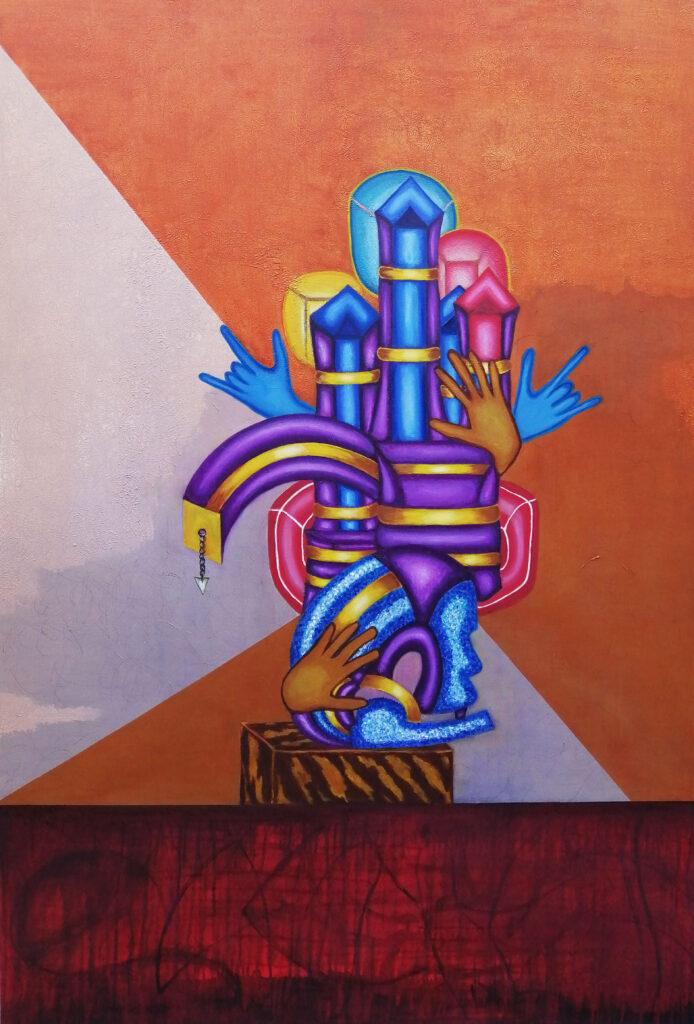
This literature includes the writings of Kabir, Nanak (founder of Sikhism), Tulsidas, Nabha Das, Gusainji, Ghanananda,] Ramananda (founder of Ramanandi sect), Sripadaraja, Vyasatirtha, Kanakadas, Vijay Das, the six Goswamis of Vrindavan, Raskhan. Huh. Teachings of saints like Ravidas, Jayadeva Goswami, Namdev, Eknath, Tukaram, Mirabai, Ramprasad Sen, Sankardev, Vallabh Acharya Narasimha Mehta, Gangasati and Chaitanya Mahaprabhu. Writers from the 7th to the early 10th centuries are known to have influenced the poet-saint driven movement. Sambandar, Tirunavukkarasar, Sundarar, Nammalvar, Adishankar, Manikvakakar and Nathamuni. Several writers of the 11th and 12th centuries developed different philosophies within the Vedanta school of Hinduism, which were influential to the Bhakti tradition in medieval India. Include Ramanuja, Madhava, Vallabh and Nimbarka. These authors supported a spectrum of philosophical positions ranging from theistic dualism, qualified monism, and absolute monism.
Although the subject is very wide, but now we will stop it here briefly and discuss Bhakti in modern art.
Bhakti in Contemporary Art
Contemporary does not mean only the art of today but it is related to the generations who contributed their art in the past which belong to the present.
Modern art in western countries was born around the 14th century and in India from the 19th century after Raja Ravi Varma: there was a revolution in the world of painting
Printing presses were established and images of God and Goddess were accessible to the common people. There were artists like Jamini Roy, Nandalal Bose and many others who contributed to Bhakti or Bhakti art.
With the Swadeshi movement gaining momentum by 1905, Indian artists attempted to revive the cultural identity suppressed by the British, rejecting the Romantic style of the Company’s paintings and the attitudes of Raja Ravi Varma and his followers. It is thus known as the Bengal School of Art, led by the Asian styles (with an emphasis on Indian nationalism) of Abanindranath Tagore (1871–1951), known as the father of modern Indian art. Other artists of the Tagore family, such as Rabindranath Tagore (1861–1941) and Gaganendranath Tagore (1867–1938), as well as early 20th-century artists such as Amrita Sher-Gil (1913–1941), introduced the Western Styles in Indian Art.
After that came the time of modern art in the field of art. During this artists like M.F. Hussain, Tyab Mehta, Manjit Baba and others came to take devotion to a different level in art. He pulled them off differently and presented his own unique style.
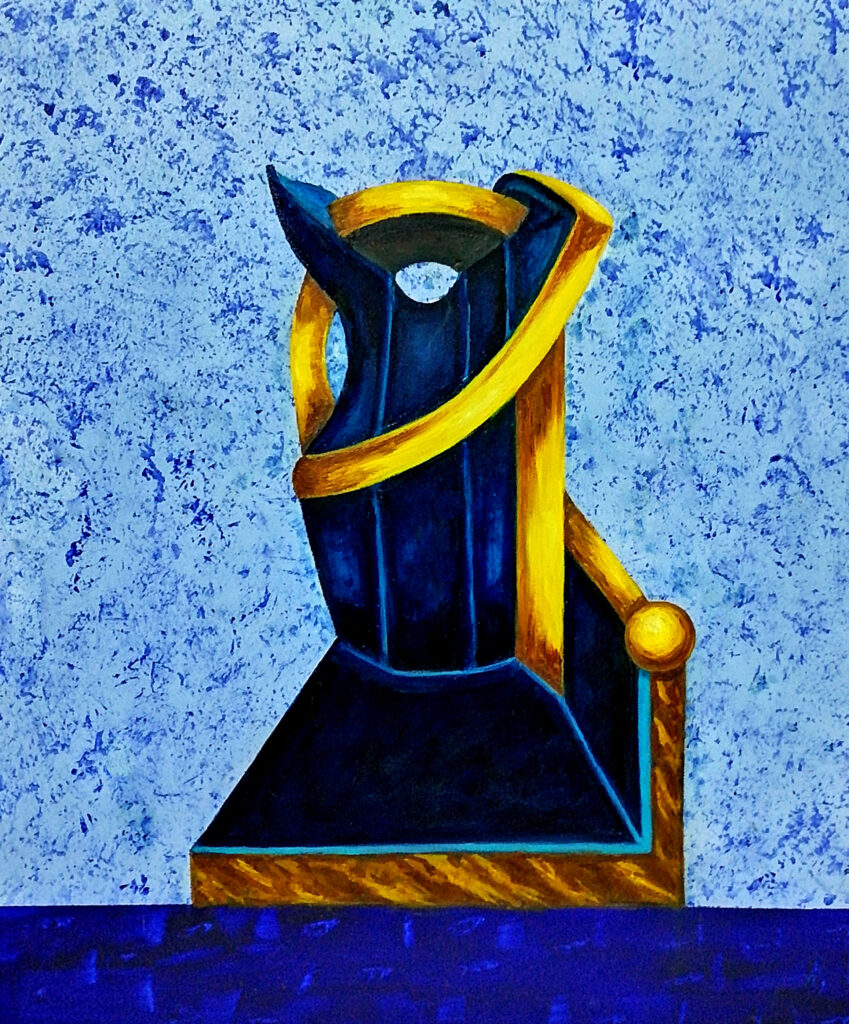
After that, in the contemporary world, came Ganesh Payne, Atul Dodiya and other artists who presented images of God with different views.
In 1947, India became independent from British rule. A group of six artists – K.H.Ara, S.K.Bakre, H.A. Gade, M.F. Hussain, S.H. Raza and Francis Newton Souza – founded the Bombay Progressive Artists Group established new ways of expressing India in the post-colonial era. Although the group was disbanded in 1956, it had a profound influence in changing the idiom of Indian art. In the 1950s almost all the leading artists of India were associated with the group. Manushi Dey, V.S. Gaitonde, Krishna Khanna, Ram Kumar, Tyab Mehta, K.G. Subramaniam, A. Ramachandran, Devendra Singh, Akbar Padamsee, John Wilkins, Himmat Shah and Manjit Bawa are some of the famous people of today. There is so much diversity in Indian art today as never before. The most famous artists of the new generation include Bose Krishnamachari and Bikash Bhattacharya. Another prominent Pakistani modernist was Ismail Gulgee, who after Circa 1960 adopted an abstract phrase that combines aspects of Islamic calligraphy with an abstract expressionist (or gesture abstractionist) sensibility.
Painting and sculpture remained in importance in the second half of the twentieth century, although they often found new directions in the work of prominent artists such as Nalini Malani, Subodhgupta, Narayanan Ramachandran, Jitish Kallat, Vivan Sundaram. Bharti Dayal has chosen to handle the traditional Mithila painting in the most contemporary way and using her imagination has created her own style, they appear fresh and unusual.
The word contemporary has a broad meaning. Art and artists have always been influenced by devotion since the last 16th century. And we find that Krishna, Shiva and Lord Rama are being accepted as the guiding sources of the Indian art of Bhakti movement. Painting and sculpture are widely influenced by the Bhakti movement in our country from north to south and south to west. We find Krishna as the centre of the Bhakti movement in Indian culture and art.
It is not about any religion; it is complete surrender of oneself to which it is not important. When you are overwhelmed and want to express yourself, you need few words or lines, colours to express, although God is formless, still He have also a positive form. Many times artist describes Him as figurative or sometimes as formless. This is a great journey inward.
According to Roger Fry (an English painter and critic) in his famous Critical and Speculative Essays on Art – “Transformations”, ” how something is represented is more important not what is represented.”
Though being an artist, in my view art and devotion are similar, yet they differ only in certain practices as per aspiration. So there is this journey of knowing oneself through art from beginning to end and this is what is called Bhakti in art.
Riddhima
?if this blog is in anyway helpful to you or what is your opinion about this or on what topic you want to see the next blog – please comment below. ?
https://artistinterest.blogspot.com/2020/08/devotion-and-contemporary-art-in-india.html
https://artistinterest.blogspot.com/2020/08/devotion-and-contemporary-art-in-india_17.html
Contemporary Art World
A normal explanation of the word – “contemporary art” refers to art made and produced by artists living today. The classification of “art of today” as a distinctive sort of art, instead of an overall adjectival phrase, goes back to the beginnings of Modern Art in London. Their art is a dynamic combination of materials, methods, concepts, and subjects that continue the challenging of boundaries that was already well underway in the 20th century.

Yet, this style of art is difficult to define because it includes such variety. Some argue that the basic approach and goal of modern Art is to challenge the nature of artwork itself. It can also make the viewer question what it is that defines art. Therefore, this style of art is not particularly uniform, and it may be more challenging to precisely describe than any other genre of art.
Since the early 20th century, some artists have turned away from realistic representation and the depiction of the human figure, and have moved increasingly towards abstraction. In New York City after World War II, the art world coined the term “abstract expressionism” to characterize an art movement that was neither completely abstract, nor expressionistic.
These shifting strategies to engage the viewer show how contemporary art’s significance exists beyond the object itself. Its meaning develops from cultural discourse, interpretation and a range of individual understandings, in addition to the formal and conceptual problems that first motivated the artist.
First of all, we need to start with the fact that the modern term of art has emerged only around the 18th century, Before that time art had- had largely a serviceable purpose as a part of the religious tradition or manifestation of the owner’s wealth.
some art scholars and art critiques, argue that artists need to have been formally educated and should be working within the trained area of modern art. This allows these artists to match the general this field’s historical context, no matter how diverse it may already be. Artists may then have their artwork exhibited at art galleries or museums. This art like other styles is also bought and sold through private collectors and art auctions.
A common concern since the early part of the 20th century has been the question of what constitutes art. The concerns of contemporary art come in for criticism too. contemporary art became a part of popular culture, with artists becoming stars, but this did not lead to a hoped-for “cultural utopia”. but contemporary art is all about getting away from tradition. It’s about stretching the limits.
I’m not admiring to take some wheat and spread them, or a mirror – break that only and seems people admiring them for no reason- if it’s not defined reasonably but there’s something to that idea that the world can be seen with wonder and awe. There’s something to the ideas that just certain shapes, or contrasts in color, or random images in general can bring us emotion, cause inspiration and stretch our imaginations.
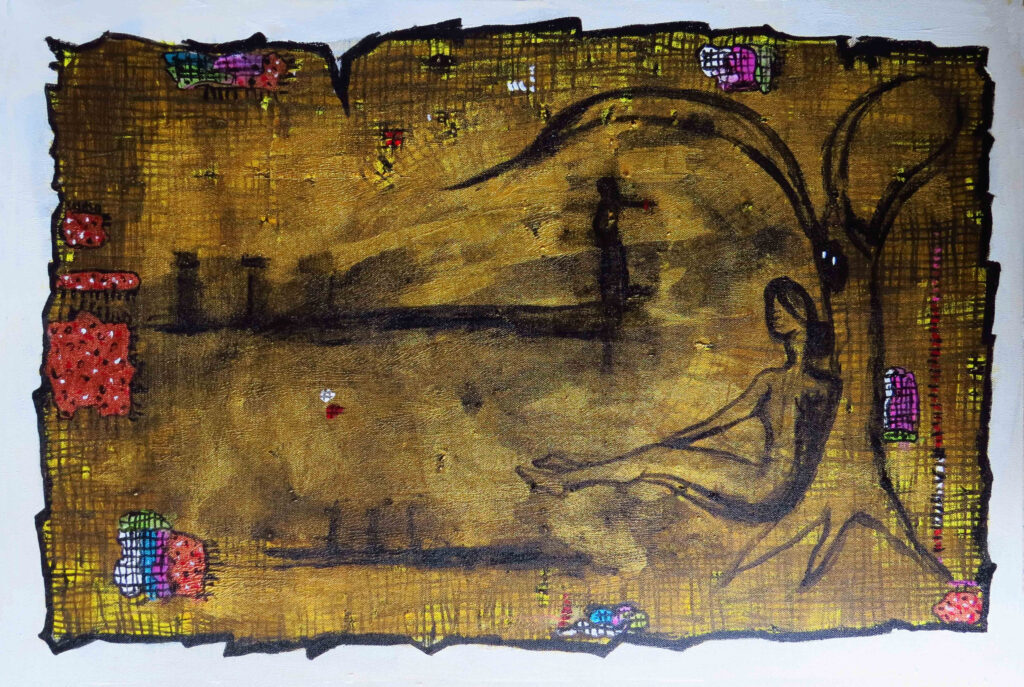
As this is very difficult to explain contemporary art similarly it is more difficult to explain it’s approach to art. It’s like formless (nirakara) or to define the shape of water. And when the artist grows in his vision became a contemporary artist. I’m not talking about those works that are repetitive in nature but fresh as a new flower. you can say here that the flowers of same plant have same fragrance and same shape and color but there is a fixed difference in all of them. so here is also I’m feeling lack of word to explain the importance of contemporary art still it touches the heart.
?if this blog is in anyway helpful to you or what is your opinion about this or on what topic you want to see the next blog – please comment below. ?
ARTISTTECH
Art means a life that shine.

